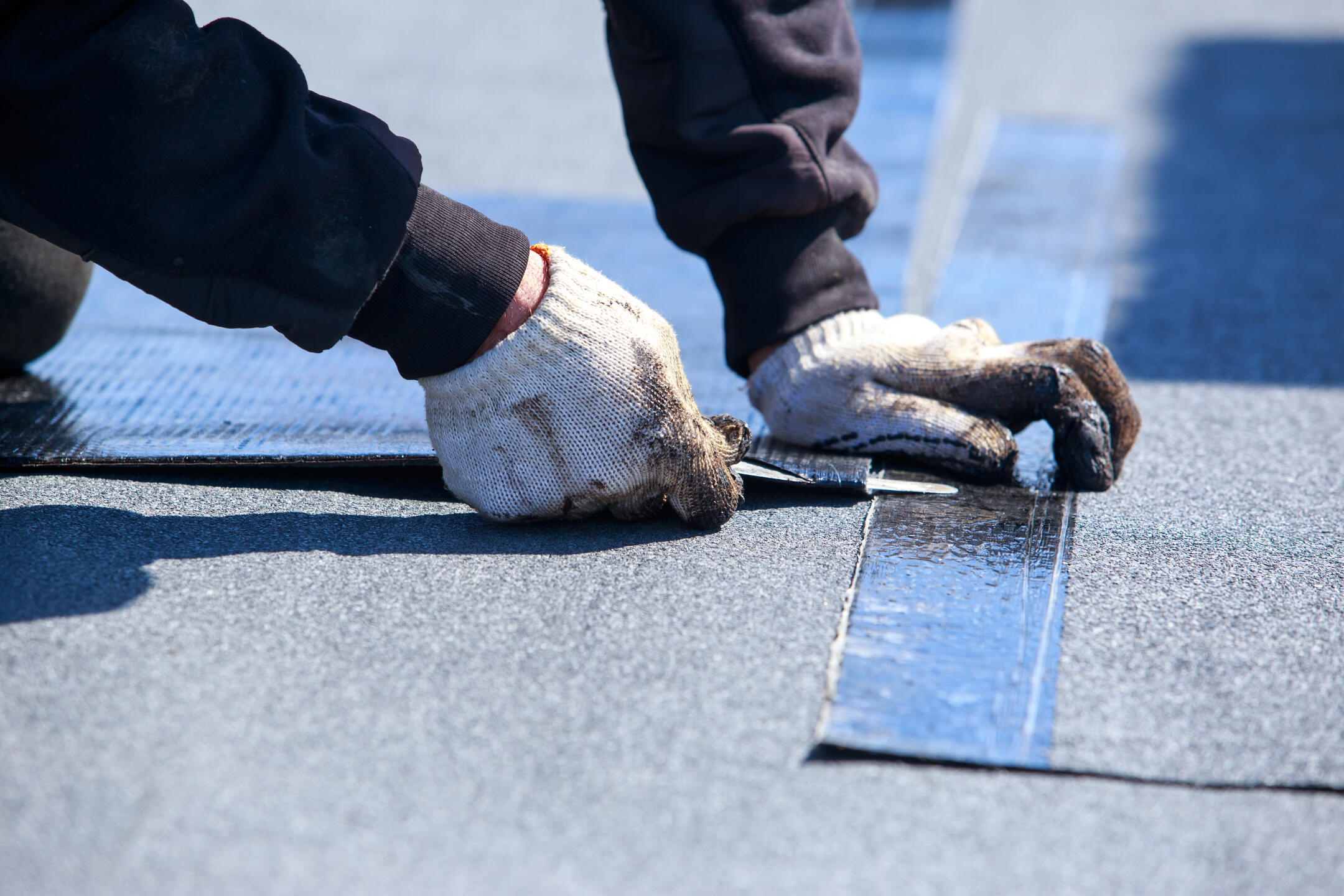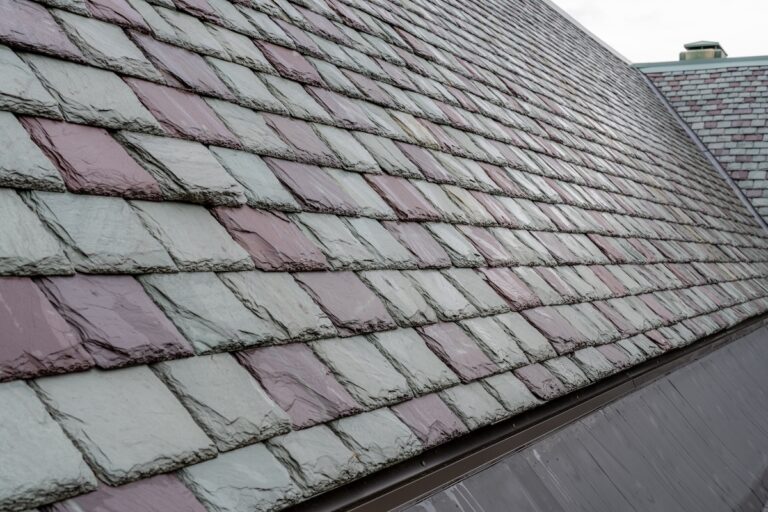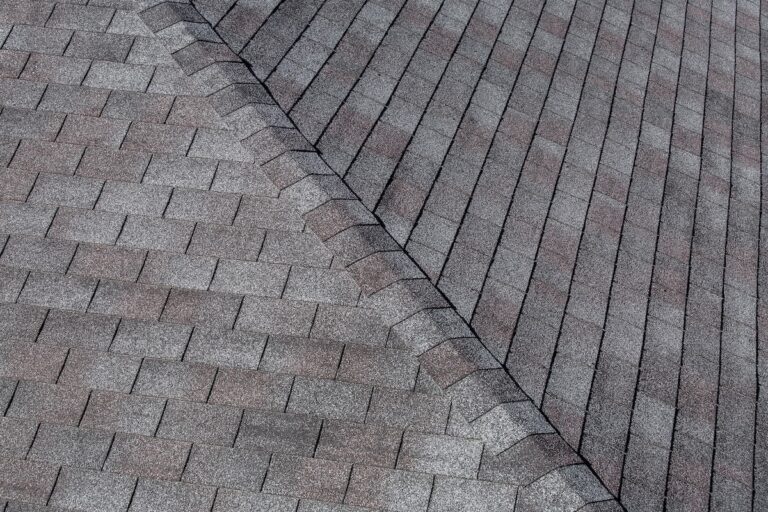Flat roofs are a popular choice for commercial properties, thanks to their affordability and modern look. However, when issues arise, repairing a flat roof can often feel overwhelming, especially for property managers handling multiple buildings. From dealing with leaks to identifying the right repair options, knowing where to start can save you time, frustration, and money. This guide will walk you through everything you need to know about flat roof repair, including:
- Common issues faced by flat roofs
- Why flat roof repairs are different
- Types of flat roof repairs
- Understanding flat roof repair costs
- Hiring the right flat roof repair contractor
🏢 Why Flat Roof Repairs Are Different
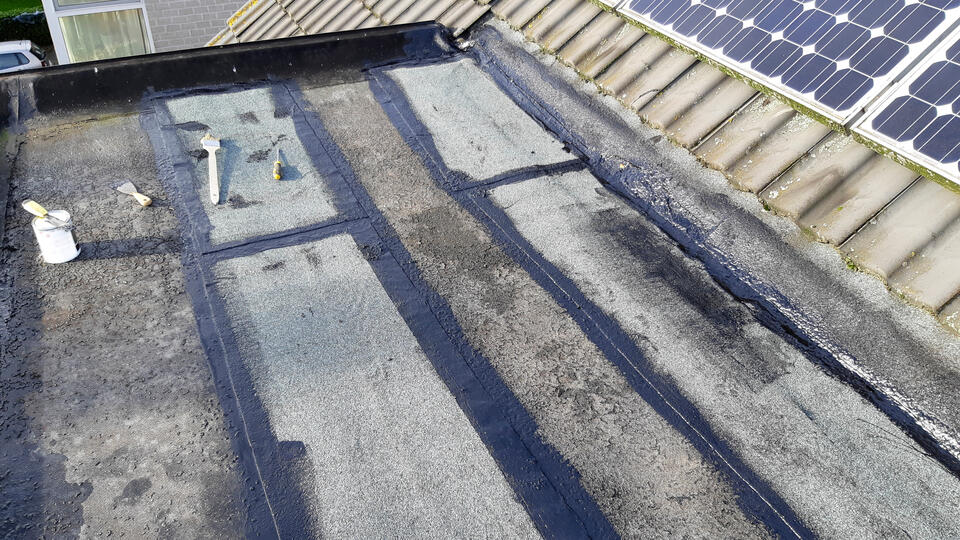
Repairing a flat roof is more complex than a pitched roof due to their unique structure and materials. Property managers should understand these key differences:
- Drainage Challenges: Unlike pitched roofs, flat roofs don’t naturally shed water, leading to potential pooling and leaks. Proper drainage systems like scuppers, internal drains, or tapered insulation must be carefully planned and maintained during repairs to prevent water damage.
- Specialized Materials: Flat roofs often rely on materials like EPDM, TPO, or built-up roofing (BUR), each requiring specific expertise. Repairs must ensure proper sealing, durability, and compatibility with the existing material to avoid further issues.
- Access and Safety: While flat roofs are easier to access for inspections or repairs, that convenience can lead to complacency. Poorly executed fixes or failure to address underlying issues can result in long-term damage, emphasizing the importance of skilled professionals for effective repairs.
❗️ Common Issues Faced by Flat Roofs
Flat roofs are prone to specific challenges that property managers must understand to maintain their longevity and functionality. Due to their design, flat roofs often experience problems related to water drainage, material wear, and structural components. Addressing these issues early can help avoid costly repairs or replacements.
Water Pooling
One of the most common issues with flat roofs is water pooling. Unlike pitched roofs that allow water to run off, flat roofs lack the natural slope needed for efficient drainage. Rainwater can collect in low spots, creating standing water that may sit for days or weeks. Over time, this pooling can weaken the roof’s structure, increase the risk of leaks, and even promote mold or algae growth. To prevent significant damage, property owners should ensure proper drainage systems are installed and maintained, such as scuppers, gutters, or internal drains with regular cleaning to avoid clogs.
Membrane Damage
Flat roofs rely on durable membranes like EPDM (rubber), TPO, or modified bitumen to keep water out. However, these materials are not immune to wear and tear. Over time, exposure to harsh weather, UV radiation, and foot traffic can cause the membranes to crack, blister, or develop punctures. Small damages may go unnoticed initially, but even minor breaches can allow water infiltration, leading to leaks and structural issues. Regular inspections and prompt repairs are critical to extending the lifespan of the membrane and protecting the building underneath. Additionally, applying protective coatings can reduce UV damage and reinforce the membrane’s durability.
Flashing Issues
Flashing, the material used to seal edges and roof penetrations, is another common weak point for flat roofs. Poorly installed, aged, or weather-damaged flashing can create gaps, allowing water to seep into vulnerable areas. Flashing issues are most frequently found around roof edges, chimneys, vents, air conditioning units, or skylights. Once compromised, these points of entry can lead to significant water infiltration, impacting the underlying structure and interior of the building. Regularly inspecting and repairing flashing is essential to maintaining a watertight roof. Upgrading to higher-quality flashing materials during repairs or replacements can also improve long-term performance.
Aging Materials
Flat roofs, like any other building material, have a limited lifespan. Most flat roof systems are designed to last 15-20 years, depending on the materials used and environmental factors. As the roof ages, signs of deterioration become more frequent, including cracking, shrinking, or bubbling of the membrane. Older roofs are also less resistant to extreme weather conditions, and repairs may become more costly and less effective. For property managers overseeing roofs near or past their lifespan, investing in a professional inspection can help determine whether repairs or a full replacement is the better option. Proactive maintenance, such as re-coating or reinforcing aging materials, can extend the roof’s usability for a few more years while planning for eventual replacement.
👉 5 Types of Flat Roof Repairs
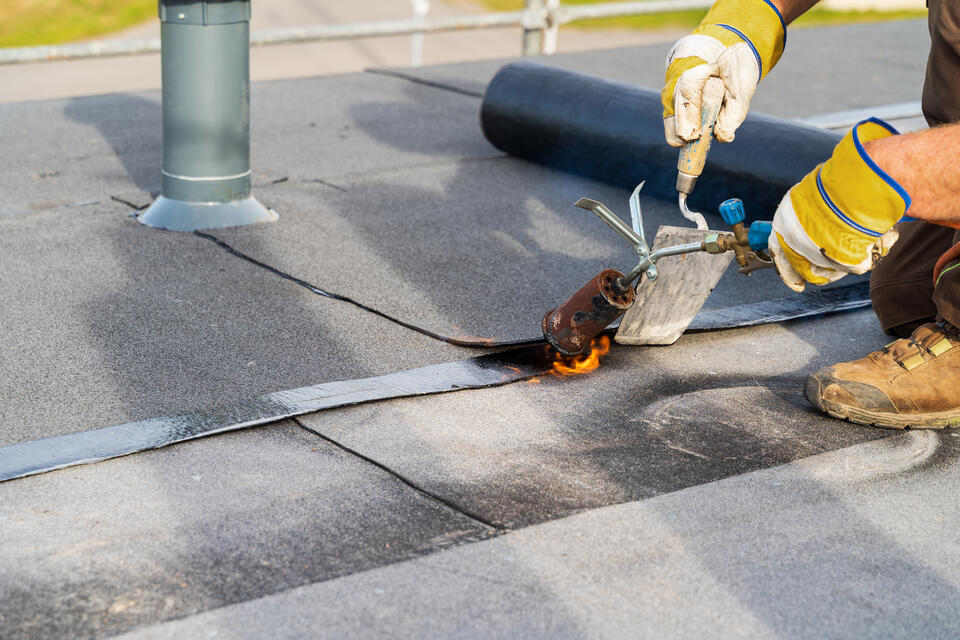
Flat roofs are durable, but like any part of a building, they can face issues over time. Not all problems require a full roof replacement—some can be solved with targeted repairs. Here are the most common types of flat roof repairs, how they’re done, and when they’re necessary:
1. Patching Small Leaks
Small leaks or punctures in the roof membrane are one of the most common problems for flat roofs. These leaks are often caused by weather damage, foot traffic, or debris. Repairing them involves thoroughly cleaning the damaged area, applying a primer, and sealing the spot with a compatible patching material that adheres to the existing roof. The goal is to create a watertight seal to prevent further leaks. This is a quick and cost-effective fix, ideal for minor damage that hasn’t spread. Regular inspections can help catch these leaks early before they lead to more extensive problems.
2. Resealing Joints and Flashing
The seams and flashing on a flat roof are critical components that help keep water out. Over time, however, the sealant used in these areas can degrade due to exposure to sun, rain, and temperature changes. When joints or flashing begin to fail, water can seep into the building, causing damage. Resealing involves removing any old, deteriorated sealant, cleaning the area, and applying a new layer of high-quality sealant to restore the waterproof barrier. This repair is particularly important after heavy storms or if you notice water pooling near these vulnerable areas.
3. Replacing Damaged Sections
Sometimes, the damage is too severe for a simple patch or resealing. Issues like widespread cracking, blistering, or rot may require cutting out and replacing the affected section of roofing material. This process involves removing the damaged area, cleaning the substrate, and installing new roofing material that matches the original. It’s a more involved repair but is necessary when the structural integrity of the roof is at risk. Replacing damaged sections can extend the life of the roof and prevent the issue from spreading further.
4. Adding a Waterproof Coating
A waterproof coating or roof restoration product is an excellent option for extending the lifespan of a flat roof that is still in relatively good condition. These coatings are applied across the entire surface of the roof and act as an additional protective layer. They can cover minor cracks, seal small leaks, and prevent UV damage. Popular materials include silicone, acrylic, or elastomeric coatings, which are highly durable and reflective. This repair not only protects the roof from water infiltration but can also improve energy efficiency by reducing heat absorption. It’s a proactive measure that’s often used to delay the need for a full roof replacement.
5. Full Roof Replacement
When a flat roof has extensive damage, recurring problems, or has simply reached the end of its lifespan, a full replacement is often the best option. This involves removing the old roofing material, inspecting the underlying structure for damage, and installing a new roof. While it’s the most expensive and time-consuming option, it provides a fresh start and ensures the building is fully protected for years to come. A full replacement is generally recommended when repairs are no longer cost-effective or when the roof is over 20-30 years old, depending on the material.
💵 Understanding Flat Roof Repair Costs
Knowing what to budget for flat roof repairs can help you avoid surprises and make informed decisions about maintenance and repairs. The cost of flat roof repairs can vary widely depending on several factors. Here’s a detailed breakdown of what influences these costs:
Size of the Roof
The size of your roof plays a crucial role in determining repair costs. Larger roofs naturally require more materials like membranes, sealants, or insulation, and they also demand more labor, which increases overall costs. For example, repairing a 500-square-foot section will be much less expensive than addressing issues on a 2,000-square-foot roof. Additionally, larger roofs often have more complex issues, like widespread damage or multiple leaks, further driving up expenses. Contractors typically charge based on square footage, so understanding the size of the repair area can give you a clearer idea of what to expect.
Type of Repair
The extent and type of repair needed will significantly impact the cost. Simple repairs, like patching small leaks, are relatively affordable and may only involve sealing cracks or replacing a small section of damaged material. These repairs can range from $300 to $1,000. However, more extensive repairs, such as fixing structural damage, replacing large sections of the roof, or addressing long-term water damage, can cost $5,000 to $10,000 or more. A full roof replacement, which may be necessary if the damage is severe or widespread, is the most expensive option and involves removing the old roof, installing new materials, and ensuring proper insulation and drainage systems.
Materials Used
The type of materials used in your roof repair also greatly influences the price. Different roofing materials come with varying costs and benefits:
- EPDM (Ethylene Propylene Diene Terpolymer): A cost-effective option known for its durability and flexibility. Repairs with EPDM are relatively affordable and ideal for smaller budgets.
- TPO (Thermoplastic Polyolefin): A slightly more expensive choice that offers energy efficiency and high resistance to UV rays. Repairs using TPO tend to be more durable but come at a higher price.
- Modified Bitumen: A sturdy material that is more expensive than EPDM but provides excellent waterproofing and durability. It is a solid choice for long-term solutions.
Choosing the right material can impact not just the cost but also the long-term performance of your roof.
Accessibility
The accessibility of your roof is another important cost factor. If your roof is located on a tall building, is difficult to reach, or requires specialized equipment like cranes or scaffolding, the labor costs can significantly increase. Roofs with multiple levels or those surrounded by obstacles, such as trees or neighboring structures, may require additional preparation or time to access safely. Contractors may also charge extra if special safety measures, like harnesses or guardrails, are necessary to complete the repairs.
Timing
Timing can also affect the overall cost of flat roof repairs. Emergency repairs, such as fixing a leak during a storm or addressing sudden damage outside of regular business hours, often come with higher fees due to the urgency and inconvenience for contractors. These surcharges can add hundreds or even thousands of dollars to your bill. On the other hand, scheduling your repairs in advance—especially during off-peak seasons—can help you save money. Regular maintenance and inspections can also prevent the need for costly, last-minute repairs.
👨🔧 Hiring the Right Flat Roof Repair Contractor
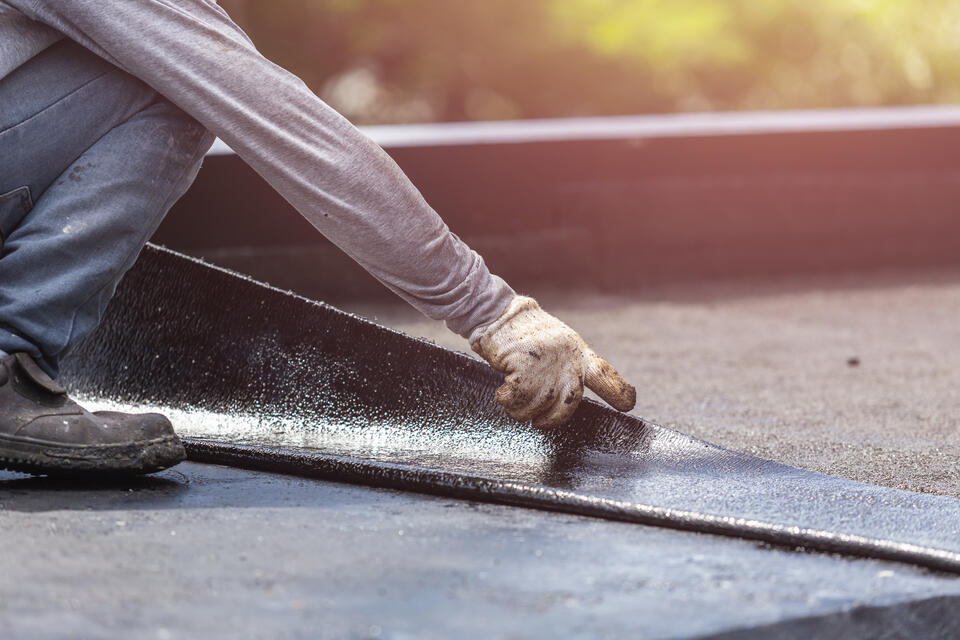
When it’s time to hire a contractor for flat roof repair, the quality of service is just as important as the cost. A poorly repaired roof can lead to recurring issues, expensive damages, and unnecessary stress. Selecting the right team ensures your roof is repaired efficiently and lasts for years to come. Here are some key tips to help you make the best decision:
- Look for Experience: Flat roofs require specific expertise, and experienced contractors ensure fewer mistakes and better solutions. Johnson Restoration has over 25 years of experience in commercial roofing, specializing in flat roof repair and maintenance. From minor fixes to complete restorations, our expertise ensures reliable, long-lasting results.
- Check References and Reviews: Customer feedback is a key indicator of a contractor’s performance. Positive reviews and testimonials reflect a company’s reliability and quality. Our team holds a 5-star Google rating and is trusted by the Dayton community for exceptional service.
- Ensure Proper Certifications: Certifications demonstrate a contractor’s commitment to using top-tier materials and techniques. Ask if the contractor is certified to work with specific roofing systems or materials. Johnson Restoration is a GAF Master Elite contractor, a distinction held by only a small percentage of professionals, ensuring high-quality standards and materials.
- Verify Warranties: Strong warranties indicate confidence in the quality of craftsmanship and materials. We offer a 50-year warranty on all work, providing unmatched security and peace of mind.
- The Right Contractor Makes All the Difference: Choosing a contractor with experience, positive reviews, proper certifications, and reliable warranties ensures a successful flat roof repair. With decades of expertise with exceptional service, we deliver precise and durable results.
🙌 Reliable Flat Roof Repair in Dayton
At Johnson Restoration, we combine decades of experience, exceptional craftsmanship, and a dedication to customer satisfaction to deliver the best flat roof repair solutions in the Dayton area. Our commitment to using top-quality materials, such as those approved by GAF, ensures the durability and longevity of your commercial roof. With outstanding reviews and a robust warranty backing every project, you can feel confident in choosing our team for your roofing needs. Don’t wait for small issues to become costly problems—contact Johnson Restoration today for a free inspection and reliable flat roof repair you can trust!
